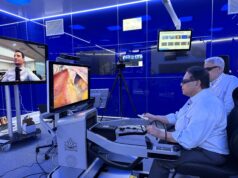
Volcano Corporation has announced US Food and Drug Administration (FDA) clearance of its proprietary instant wave-free ratio (iFR) Modality and immediate commencement of US limited market release.
The iFR Modality is a physiologic measurement performed using the same pressure wires and equipment utilised in cath labs for fractional flow reserve, but avoids injection of hyperemic agents into the patient that induce stress to the heart. This allows for a meaningful, lesion-specific assessment in seconds by amplifying the resting pressure waveform. The iFR Modality is currently installed on more than 300 systems around the world, primarily in Europe and Japan. FDA clearance now means that more than 90% of Volcano’s worldwide installed base of multi-modality systems can be upgraded.
“As cardiologists today we are concerned not only with the wellbeing of our patients, but also about the efficiency with which we deliver appropriate and individualised care for a very complex problem,” comments Amir Lerman, co-principal investigator of ADVISE II and professor of medicine at the Mayo Clinic in Rochester, USA. “Stents have proven beneficial when used selectively in patients that demonstrate a functional deficiency, and fractional flow reserve is a terrific tool to identify the specific lesion causing the problem. Instant wave-free ratio will further increase efficiency by reducing the time, cost and complexity required to properly identify lesions causing this functional deficiency, and then confirming the problem is resolved by the stent.”
The iFR Modality is used most efficiently with Volcano’s recently-introduced Verrata Pressure Guide Wire, which is designed for simple disconnection and reattachment during a procedure, and facilitates making quick measurements multiple times during a procedure without injecting hyperemic agents each time.
“We are extremely excited that both the iFR Modality and Verrata can now be made available to clinicians here in the United States, as the two tools are designed to be used together,” comments Joe Burnett, executive vice president and general manager of the Functional Management Business at Volcano. “In Europe, where we are now seeing how physicians use the two technologies alongside fractional flow reserve, the feedback has been very positive. In the past, physicians would place the wire in the vessel, perform an fractional flow reserve to ‘justify’ the need for intervention, and then return to the angiogram to ‘guide’ how many stents should be placed and where. Adding the iFR Modality and Verrata to the picture, that same physician can now not only perform fractional flow reserve to identify the vessel that needs treatment, but also can switch to instant wave-free ratio to quickly identify which lesion causes the largest drop in pressure, place a stent, and then re-connect to confirm that the stent helped reduce the pressure drop. This is a workflow that would be very uncommon with older wire technology and the need for multiple drug infusions. This helps to evolve physiology from a justification tool to a guidance tool.”
The performance of the iFR Modality has been tested prospectively in approximately 800 patients as part of the ADVISE II (Adenosine vasodilator independent stenosis evaluation) study which was presented as a late breaking clinical trial at Transcatheter Cardiovascular Therapeutics meeting last fall. The iFR Hybrid Approach Analysis performed on the independently-held ADVISE II dataset was the first prospective, real world registry comparing instant wave-free ratio and fractional flow reserve and it demonstrated a statistically high correlation (sensitivity 90.7% for fractional flow reserve less than or equal to 0.80, specificity 96.2% for fractional flow reserve greater than 0.80). The hybrid method would have avoided the need to use a hyperemic agent in 65.1% of this patient population. Patients in ADVISE II were recruited from more than 40 centres in the United States and Europe, and all procedures were performed with operators blinded to the instant wave-free ratio values which were calculated offline at an independent core lab in Rotterdam, the Netherlands.










